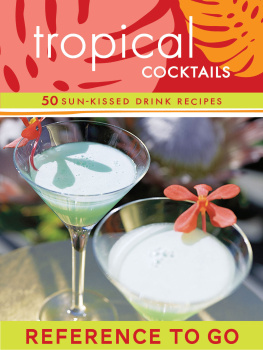Mini Bar Gin
by MITTIE HELLMICH
photographs by Frankie Frankeny

A huge thanks to the fabulously creative project manager Mary Wruck for her savvy attention to detail, and to the meticulous copy editor Jonathan Kauffman. And a special thanks to Hudson Pierce-Rhoads, Geoffrey Rhoads, and Rick Van Oel.MH
Text copyright 2007 by Mittie Hellmich. Photographs copyright 2007 by Frankie Frankeny. All rights reserved. No part of this book may be reproduced in any form without written permission from the publisher.
Library of Congress Cataloging-in-Publication Data available.
eISBN 13: 978-1-4521-0010-4
Drink styling by Alison Richmond
From Frankie: Thanks to Pamela Geismar and Leslie Jonath.
Chronicle Books LLC
680 Second Street
San Francisco, CA 94107
http://www.chroniclebooks.com
Aliz is a registered trademark of Tradewinds Importing Co., Inc. Angostura bitters is a registered trademark of Angostura International Ltd. Bndictine is a registered trademark Bndictine Distillerie de la Liqueur de lAncienne Abbaye de Fcamp. Bombay Sapphire is a registered trademark of Bacardi & Co. Ltd. Campari is a registered trademark of Davide Campari-Milano S.P.A. Chartreuse is a registered trademark of Chartreuse Corporation. Cointreau is a registered trademark of Cointreau Corporation. Galliano is a registered trademark of Remy Finance B.V. Kahla is a registered trademark of Heaven Hill Distilleries Inc. Lillet is a registered trademark of Socit Lillet Frres. Noilly Prat is a registered trademark of Etablissements Noilly Prat & Cie. Pernod is a registered trademark of Pernod Ricard. Peychauds is a registered trademark of Sazerac Co., Inc. Punt e Mes is a registered trademark of G.B. Carpano S.R.L. Roses is a registered trademark of L. Rose & Co., Ltd. Tuaca is a registered trademark of Distillerie Tuoni & Canepa S.P.A.
GIN IS THE QUINTESSENTIAL COCKTAIL LIQUOR, one that has inspired many classic cocktails, from the Martini and the Negroni to slings, fizzes, rickeys, and collinses. Historically infamous, gin has swung between extremes of taste and class, from the dangerous swill produced by London gin houses to the glamorous spirit made fashionable by the literary set and Hollywood during the golden age of cocktails.
The origins of gin are rooted in juniper-based medicinal cures that were first distilled by Italian monks around 1150. But we can raise our martini glass to the Dutch for refining the distillation process and making the apothecarys tonic into a recreational tipple. By the 1650s, the Dutch were producing genever (which the word gin is derived from), a drinkable spirit with an intense juniper bouquet.
English mercenaries who aided the Dutch during the Thirty Years War (161848) brought home more than a few bottles of Dutch courage, but Englands thorny love affair with the spirit really began with William III, a Dutch aristocrat who assumed the British throne in 1689. He brought along his preference for Holland gin, and soon the ports of Bristol, Plymouth, and London became major distilling centers. Imbibed from the fashionable Banqueting House at Hampton Court Palace (dubbed the gin temple) to the slums of London, gin became the perfect numbing distraction from reality, and by the early eighteenth century, the infamous gin shops took root, producing unregulated and dangerously bad distillates. By 1769, gins reputation was restored by Alexander Gordon, who was licensed to distill high-quality gin.
The popularity of gin in America can be followed from the turn-of-the-century bar scene, strictly for sophisticated urbanites, through the decadent 1920s, and Prohibitioneras home-distilled bathtub gin, producing harsh gins that harkened back to the infamous London gin shops. Franklin Roosevelt, a Martini aficionado, ushered in the first legal Martini in 1933, further perpetuating the already popular cult of the Martini, which eventually evolved into the maximum-dryness fetish of the 1950s and 60s.
Distilling Gin
Gin starts out like vodka, as a colorless, light-bodied spirit distilled from grain (wheat or rye) or cane (molasses). It parts company with vodka once the base spirit is flavored. Gin is distilled in column stills, producing a clean, light-bodied, high-proof spirit, and is then redistilled with botanical flavorings, usually in an Old World pot still. The quality of gin varies depending on the raw ingredients, the purity of the added water, and the method of distillation.
Beyond the usual flavors of juniper and coriander, distillers craft distinctive, complex gins by adding their own combination of botanicalsfrom clove, lemon, and orange rind to licorice, anise, and cardamom among others. The best-quality gins are redistilled with these flavorings, which are suspended within the still and vaporized into the spirit for complexity. By comparison, mass-market brands infuse the botanicals by soaking them in the base spirit and then redistilling the infused spirit. The lowest-end brands, known as compound gins, simply add essences and extracts to a neutral spirit.
Gin Types
When people refer to gin, they usually mean London dry gin, which is most often used in cocktails. However, there is a wide spectrum of styles of gin available, from pungent Holland gins to softer American dry gins, with each distiller striving to produce subtle aromatic differences.
London dry gin, classically English in style, is the traditional dry gin, light and aromatic. It is the most popular style on the market. From the mildly perfumed to the pungent, these bone-dry gins lack the sweetness of old-style Old Tom gin and are great for both mixed drinks and martinis. Similar to London dry gin, Plymouth gin (produced only in the city of Plymouth) is intensely fragrant, fuller bodied, and very dry. It makes a perfectly acceptable Martini.
Old Tom gin is one of the few remaining examples of old-style gin popular in eighteenth-century England, a slightly sweetened type similar to Hollands oude genever.
Holland still makes its classic genever, a Dutch-style gin that is highly aromatic with intense juniper flavor. Genever is produced in three styles, from dry, lighter bodied jonge (young) genevers, to pungent, slightly sweet oude (old style), as well as Korenwijn, a wood-aged genever. These are best served neat or over ice rather than used in mixed drinks.
Dry gins made in the United States tend to be softer and less flavorful than London dry gins and are best suited for mixed drinks. France produces a few gins that fall between the intensely pungent and softer, dry varieties. The newer second generation gins, which jump on the flavored vodka craze, are infused with a broad spectrum of aromatic botanicals such as orange, clove, vanilla, mixed citrus, and pear. Some leave the juniper taste so far behind that we must ask, is this technically still a gin?
Gin Mixology
Now, when it comes down to stirring and shaking, the aromatic characteristics of gin concord so marvelously with just about any ingredient, from juices to liqueurs and vermouth, that gin is a luxuriant spirit for mixed drinks. A moderate or cheaper brand is perfectly suitable for multi-ingredient mixed drinks, but a premium gin can be fully appreciated when prepared in a Martini or Gin and Tonic.
Whatever your tastes, from the sophisticated Negroni and Orange Blossom to the lively Singapore Sling, youll find that this compilation of gin drinks offers a wide spectrum of mixologically mastered classics, contemporary concoctions, and innovative cocktails, sure to inspire shaking and pouring with style.






